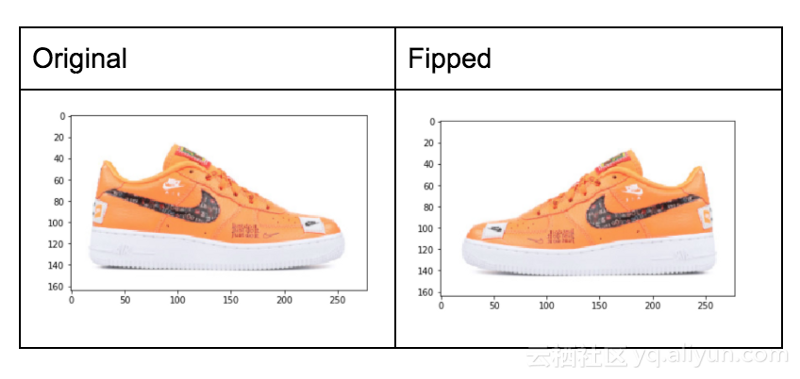import os.path
import random
import math
dir_root = 'D:/images/'
for img_name in os.listdir(dir_root):
img_path = dir_root + img_name #读取每一个图片路径
image = cv2.imread(img_path)
tfimg = tfactor(image)
rotateAngle = random.randrange(0, 10)
rotateImg = rotate(tfimg, rotateAngle)
......
From: 图像数据增强方法一览
翻转|Flipping
对图像进行翻转是最流行的图像数据增强方法之一。这主要是由于翻转图像操作的代码简单,以及对于大多数问题而言,对图像进行翻转操作能够提升模型的性能。下面的模型可以被认为是看到左鞋而不是右鞋,因此通过这种数据增加,模型对于看到鞋的潜在变化会变得更加鲁棒。

# Flipping images with Numpy
flipped_img = np.fliplr(img)
plt.imshow(flipped_img)
plt.show()From: opencv-python 图像数据增强
def SaltAndPepper(src,percetage):
SP_NoiseImg=src.copy()
SP_NoiseNum=int(percetage*src.shape[0]*src.shape[1])
for i in range(SP_NoiseNum):
randR=np.random.randint(0,src.shape[0]-1)
randG=np.random.randint(0,src.shape[1]-1)
randB=np.random.randint(0,3)
if np.random.randint(0,1)==0:
SP_NoiseImg[randR,randG,randB]=0
else:
SP_NoiseImg[randR,randG,randB]=255
return SP_NoiseImg
def addGaussianNoise(image,percetage):
G_Noiseimg = image.copy()
w = image.shape[1]
h = image.shape[0]
G_NoiseNum=int(percetage*image.shape[0]*image.shape[1])
for i in range(G_NoiseNum):
temp_x = np.random.randint(0,h)
temp_y = np.random.randint(0,w)
G_Noiseimg[temp_x][temp_y][np.random.randint(3)] = np.random.randn(1)[0]
return G_Noiseimg
#dimming
def darker(image,percetage=0.9):
image_copy = image.copy()
w = image.shape[1]
h = image.shape[0]
#get darker
for xi in range(0,w):
for xj in range(0,h):
image_copy[xj,xi,0] = int(image[xj,xi,0]*percetage)
image_copy[xj,xi,1] = int(image[xj,xi,1]*percetage)
image_copy[xj,xi,2] = int(image[xj,xi,2]*percetage)
return image_copy
def brighter(image, percetage=1.5):
image_copy = image.copy()
w = image.shape[1]
h = image.shape[0]
#get brighter
for xi in range(0,w):
for xj in range(0,h):
image_copy[xj,xi,0] = np.clip(int(image[xj,xi,0]*percetage),a_max=255,a_min=0)
image_copy[xj,xi,1] = np.clip(int(image[xj,xi,1]*percetage),a_max=255,a_min=0)
image_copy[xj,xi,2] = np.clip(int(image[xj,xi,2]*percetage),a_max=255,a_min=0)
return image_copy
def rotate(image, angle=15, scale=0.9):
w = image.shape[1]
h = image.shape[0]
#rotate matrix
M = cv2.getRotationMatrix2D((w/2,h/2), angle, scale)
#rotate
image = cv2.warpAffine(image,M,(w,h))
return image
def img_augmentation(path, name_int):
img = cv2.imread(path)
img_flip = cv2.flip(img,1)#flip
img_rotation = rotate(img)#rotation
img_noise1 = SaltAndPepper(img, 0.3)
img_noise2 = addGaussianNoise(img, 0.3)
img_brighter = brighter(img)
img_darker = darker(img)
cv2.imwrite(save_path+'%s' %str(name_int)+'.jpg', img_flip)
cv2.imwrite(save_path+'%s' %str(name_int+1)+'.jpg', img_rotation)
cv2.imwrite(save_path+'%s' %str(name_int+2)+'.jpg', img_noise1)
cv2.imwrite(save_path+'%s' %str(name_int+3)+'.jpg', img_noise2)
cv2.imwrite(save_path+'%s' %str(name_int+4)+'.jpg', img_brighter)
cv2.imwrite(save_path+'%s' %str(name_int+5)+'.jpg', img_darker)